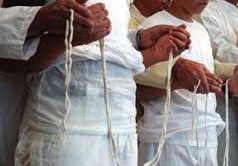Choosing the Zoroastrian Path:
A Journey Toward Truth and Integrity
1. Embracing the Zoroastrian Faith
According to Article 8 of the Universal Declaration of Human Rights,
“Everyone has the right to choose their own religion and to live
according to their beliefs.”This principle empowers each person
to explore the teachings of the Gathas—the hymns of
Zarathushtra—and live by the Zoroastrian way of life.
Zarathushtra himself encouraged people to think freely and use
their good minds. He invited individuals—starting with those closest
to him, including kings and leaders—to explore and adopt his
teachings. That invitation was not forced or exclusive; it was open to
anyone seeking a life based on good thoughts, good words, and
good deeds. This message of free choice is clearly expressed in
the Gathas.
So today, anyone who finds meaning in these teachings has the
full human right to adopt the Zoroastrian path. You don’t need
anyone’s permission. The Sedreh Pushi (the ceremony of initiation)
marks a symbolic commitment to this path and is usually
performed publicly, as a way of joining the larger Zoroastrian
community.
2. Being Part of a Zoroastrian Community
Humans are social beings. After choosing a spiritual path, it’s natural to seek a community that shares your values. Joining the Zoroastrian community isn’t just about religion—it’s about meaningful relationships, shared culture, and belonging.
That said, because of Zoroastrianism’s deep and ancient heritage, becoming part of the community also means taking time to understand its traditions. That understanding helps you find your place and enjoy the social, cultural, and spiritual benefits of the Zoroastrian way of life.
3. Understanding the Global Zoroastrian Community
Today, the global Zoroastrian community includes three main branches:
\Zoroastrians of Iran.
Parsis of India. Behdins
(New Zoroastrians)
Each group has its own cultural style and religious practices, but all are united in honoring Zarathushtra’s core teachings.
3.1 Zoroastrians of Iran
Iranian-born Zoroastrians have preserved the faith through centuries of hardship under dynasties like the Safavids, Qajars, and others. Their priests safeguarded the Avesta—particularly the Gathas—during times of extreme pressure. They tend to practice a moderate approach, blending tradition with flexibility. They’re respected across Iran for their integrity, and their contributions during the Pahlavi era were profound—founding schools, hospitals, and charities. Leaders like Keykhosrow Shahrokh, Arbab Rostam Giv, Dr. Farhang Mehr, and General Khodarahm Shahriari represent the strength and dignity of this branch.
3.2 Parsis of India
The Parsis are descendants of Iranian Zoroastrians who migrated to India roughly 1,400 years ago, fleeing Islamic conquest. In India, they’ve flourished—economically, intellectually, and culturally.They’re known for their strong devotion to traditional rituals and practices. Notable Parsis include Field Marshal Sam Manekshaw, J.R.D. Tata, and Feroze Gandhi. Their success is a shining example of perseverance and cultural preservation.
3.3 Behdins (New Zoroastrians)
From the time of the Pahlavi dynasty and increasingly under the Islamic Republic, many Iranians began to return to their ancestral faith. These Behdins tend to focus on the Gathas and the spiritual philosophy of Zarathushtra.Figures like Professor Pourdavoud, General Aryana, and Dr. Jafari have played key roles in reviving this modern Zoroastrian movement. The term Behdin comes from the Gathic phrase “Daena Vanghuyā”—meaning “Good Conscience.” Over time, it became a title for those who align their lives with Zoroastrian principles.
3.4 Diversity of Thought Within the Community
Each branch of the Zoroastrian world holds different perspectives:
Parsis often lean traditional, Iranian-born Zoroastrians are typically moderate, and Behdins are more Gatha-focused. But within each group, there’s diversity. Some Parsis promote modern Zoroastrian ideas, while some Behdins prefer ancient rituals. Zoroastrianism celebrates freedom of thought. No matter which path you follow, you belong to this spiritual family.
A Word on Cultural Identity
As Parsi scholar Khurshid Mistry once said:
“Parsis are a historical phenomenon—you don’t become one, you are born into it. ”Cultural identity is inherited and rooted in deep history. As President Ronald Reagan once remarked, “You don’t become French or Turkish just by getting a passport.” Choosing Zoroastrianism doesn’t mean becoming a Parsi or claiming ancient heritage—it means choosing a spiritual path that leads you to a better, more thoughtful life.
4. Unity and Respect Among All Branches
True collaboration comes through mutual respect. A powerful example is Spenta University’s Pune campus, where Parsis, Iranian Zoroastrians, and Behdins worked side by side to share Zarathushtra’s message through education. No one tried to dominate. Everyone honored each other’s traditions. That spirit of dignity, humility, and cooperation is what keeps the Zoroastrian community strong. Today’s Zoroastrian youth recognize this need for unity. Together, they are building a community that stands as a global symbol of integrity, wisdom, and solidarity.
In Conclusion
As the Universal Declaration of Human Rights affirms: Everyone has the freedom to choose their religion. Zarathushtra invites you—not forces you—to walk the path of Asha. And once you’ve embraced this path and completed your Sedreh Pushi ceremony—whether with a Mobed, Dastur, or Ratu—the Behdin Fellowship welcomes you with open arms. It’s not just a faith — it’s a way of living, a community to grow in, and a spiritual heritage that calls out to the truth-seeker in all of us.


